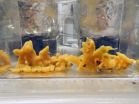(Press-News.org) High levels of the stress hormone cortisol may contribute to the risk aversion and 'irrational pessimism' found among bankers and fund managers during financial crises, according to a new study.
The study's authors say that risk takers in the financial world exhibit risk averse behaviour during periods of extreme market volatility – just when a crashing market most needs them to take risks – and that this change in their appetite for risk may be "physiologically-driven", specifically by the body's response to cortisol. They suggest that stress could be an "under-appreciated" cause of market instability.
Published today in the journal Proceedings of the National Academy of Sciences, the study conducted at the Cambridge Judge Business School and the Department of Medicine's Institute of Metabolic Science is the first to show that personal financial risk preferences fluctuate substantially, and these fluctuations may be linked to hormone response.
The finding could fundamentally alter our understanding of risk as, up until now, almost every model in finance and economics – even those used by banks and central banks – rested on the assumption that traders' personal risk preferences stay consistent across the market cycle, say the authors.
In a previous study conducted with real traders in the City of London, researchers observed that cortisol levels rose 68% over a two week period when market volatility increased. In the latest study they combined field work with lab work, a rare approach in economics, to test for the effects of this elevated cortisol on financial risk-taking.
The researchers administered hydrocortisone – the pharmaceutical form of cortisol – to 36 volunteers, 20 men and 16 women, aged 20 to 36 years, over an eight day period, raising their cortisol levels 69%: almost exactly the levels seen in the traders.
The volunteers took part in lottery-style financial risk-taking tasks with real monetary pay-offs, designed to measure the preferences for risky gambles and the judgments of probability underlying their risk taking. While initial spikes of cortisol had little effect on behaviour, chronically high and sustained levels, as seen in traders, led to a dramatic drop in participants' willingness to take risks, with the 'risk premium' – the amount of extra risk someone will tolerate for the possibility of higher return – falling by 44%.
"Any trader knows that their body is taken on rollercoaster ride by the markets. What we haven't known until this study was that these physiological changes - the sub-clinical levels of stress of which we are only dimly aware - are actually altering our ability to take risk," said Dr John Coates, co-lead of the study from the Cambridge Judge Business School, and a former Wall Street derivatives trader himself.
"It is frightening to realize that no one in the financial world – not the traders, not the risk managers, not the central bankers – knows that these subterranean shifts in risk appetite are taking place."
Cortisol is a hormone secreted by the adrenal glands in response to moments of high physical stress, such as 'fight or flight'. Importantly, cortisol also rises powerfully in situations of uncertainty, such as volatility in the financial markets. Cortisol prepares us for possible action by releasing glucose and free fatty acids into the blood. It also suppresses any bodily functions not needed during a crisis - such as the digestive, reproductive, and immune systems.
However, should this stress become chronic, as it might during a prolonged financial crisis, the elevated cortisol can contribute to impaired learning, heightened anxiety, and eventually depression. The current study has now shown that in addition to these known pathologies, chronic stress can also lead to a substantial decrease in the willingness to take financial risks, say the researchers.
They also suggest that an unsuspected side effect of anti-inflammatory treatments such as prednisone may be financial risk aversion.
The study's authors also looked for differences between men and women. While other researchers have argued that women are more risk averse than men, the current study found no differences between the sexes under normal circumstances. However, the study did find that, when exposed to chronically-raised levels of cortisol, men placed too much importance on smaller risks, while women did not.
The authors point out that during the Credit Crisis of 2007 to 2009 volatility in US equities spiked from 12% to over 70%. They argue that it is reasonable to assume that such historically high levels of uncertainty would have caused stress hormones to rise far higher and longer than the team had been able to observe in their study.
Chronic stress may therefore have decreased risk taking just when the economy needed it most – when markets were crashing and needed traders and investors to buy distressed assets, they say. Physiologically-driven shifts in risk preferences may be a source of financial market instability that hasn't been considered by economists, risk managers and central bankers alike.
Added Coates: "Traders, risk managers, and central banks cannot hope to manage risk if they do not understand that the drivers of risk taking lurk deep in our bodies. Risk managers who fail to understand this will have as little success as fire fighters spraying water at the tips of flames."
INFORMATION: END
Stress hormones in traders may trigger 'risk aversion' and contribute to market crises
2014-02-18
ELSE PRESS RELEASES FROM THIS DATE:
How well do football helmets protect players from concussions?
2014-02-18
PHILADELPHIA – A new study finds that football helmets currently used on the field may do little to protect against hits to the side of the head, or rotational force, an often dangerous source of brain injury and encephalopathy. The study released today will be presented at the American Academy of Neurology's 66th Annual Meeting in Philadelphia, April 26 to May 3, 2014.
"Protection against concussion and complications of brain injury is especially important for young players, including elementary and middle school, high school and college athletes, whose still-developing ...
How evolution shapes the geometries of life
2014-02-18
Why does a mouse's heart beat about the same number of times in its lifetime as an elephant's, although the mouse lives about a year, while an elephant sees 70 winters come and go? Why do small plants and animals mature faster than large ones? Why has nature chosen such radically different forms as the loose-limbed beauty of a flowering tree and the fearful symmetry of a tiger?
These questions have puzzled life scientists since ancient times. Now an interdisciplinary team of researchers from the University of Maryland and the University of Padua in Italy propose a thought-provoking ...
Theory on origin of animals challenged: Animals needs only extremely little oxygen
2014-02-18
One of science's strongest dogmas is that complex life on Earth could only evolve when oxygen levels in the atmosphere rose to close to modern levels. But now studies of a small sea sponge fished out of a Danish fjord shows that complex life does not need high levels of oxygen in order to live and grow.
The origin of complex life is one of science's greatest mysteries. How could the first small primitive cells evolve into the diversity of advanced life forms that exists on Earth today? The explanation in all textbooks is: Oxygen. Complex life evolved because the atmospheric ...
Researchers warn against abrupt stop to geoengineering method
2014-02-18
As a range of climate change mitigation scenarios are discussed, University of Washington researchers have found that the injection of sulfate particles into the atmosphere to reflect sunlight and curb the effects of global warming could pose a severe threat if not maintained indefinitely and supported by strict reductions in greenhouse gas (GHG) emissions.
The new study, published today, 18 February, in IOP Publishing's journal Environmental Research Letters, has highlighted the risks of large and spatially expansive temperature increases if solar radiation management ...
First biological marker for major depression could enable better diagnosis and treatment
2014-02-18
Teenage boys who show a combination of depressive symptoms and elevated levels of the 'stress hormone' cortisol are up to fourteen times more likely to develop major depression than those who show neither trait, according to research funded by the Wellcome Trust.
In a study published today in the Proceedings of the National Academy of Sciences, researchers from the University of Cambridge have identified the first biomarker – a biological signpost – for major, or clinical, depression. They argue that this could help identify those boys in particular at greatest risk ...
Why tackling appetite could hold the key to preventing childhood obesity
2014-02-18
A heartier appetite is linked to more rapid infant growth and to genetic predisposition to obesity, according to two papers published in JAMA Pediatrics today (Monday).
The studies investigated how weight gain is linked to two key aspects of appetite, namely lower satiety responsiveness (a reduced urge to eat in response to internal 'fullness' signals) and higher food responsiveness (an increased urge to eat in response to the sight or smell of nice food).
The first paper reveals that infants with a heartier appetite grew more rapidly up to age 15 months, potentially ...
Ancient herring catch nets fisheries weakness
2014-02-18
Archaeological data indicate modern herring management needs to take a longer look into the past to manage fisheries for the future says a new study involving Simon Fraser University researchers.
That is one of the key findings in the study, just published online in Proceedings of the National Academy of Sciences (PNAS). SFU researchers Iain McKechnie, Dana Lepofsky and Ken Lertzman, and scientists in Ontario, Alberta and the United States are its co-authors.
The study is one of many initiatives of the SFU-based Herring School, a group of researchers that investigates ...
'It takes a village' -- Community-based methods for improving maternal and newborn health
2014-02-18
A series of studies are published in a special supplement that presents results of the Maternal and Newborn Health in Ethiopia Partnership—a three-year pilot program funded by the Bill & Melinda Gates Foundation with the goal of improving the health of Ethiopian mothers and their newborns. This special issue of the Journal of Midwifery & Women's Health is published by Wiley on behalf of the American College of Nurse-Midwives.
High mortality rates for pregnant women and newborns continue to be a major health concern in Africa, with Ethiopia being one of the most affected ...
Mitosis mystery solved as role of key protein is confirmed
2014-02-18
Researchers from Warwick Medical School have discovered the key role of a protein in shutting down endocytosis during mitosis, answering a question that has evaded scientists for half a century.
The study, published today in the journal eLife, is the first to outline the role of actin, a protein, in shutting down clathrin-dependent endocytosis during mitosis.
Endocytosis is the process by which cells absorb molecules that are too large to pass through the plasma membrane, such as proteins. Clathrin-dependent endocytosis is the most common route for this. Clathrin, a ...
Learning to see better in life and baseball
2014-02-17
With a little practice on a computer or iPad—25 minutes a day, 4 days a week, for 2 months—our brains can learn to see better, according to a study of University of California, Riverside baseball players reported in the Cell Press journal Current Biology on February 17. The new evidence also shows that a visual training program can sometimes make the difference between winning and losing.
The study is the first, as far as the researchers know, to show that perceptual learning can produce improvements in vision in normally seeing individuals.
"The demonstration that ...



